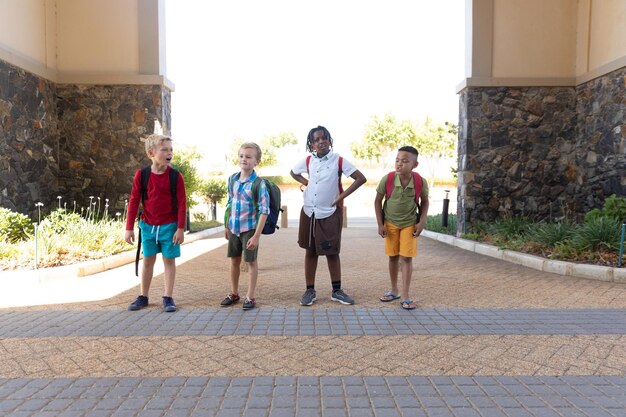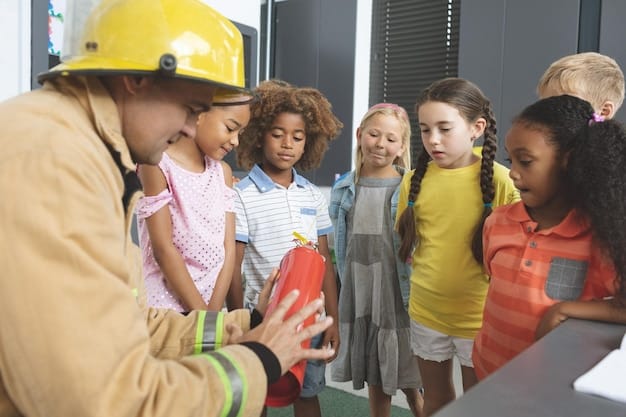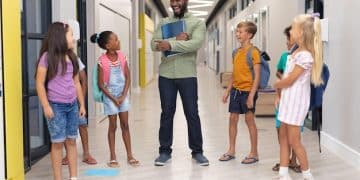School Zone Emergency Preparedness: A Parent’s & Student’s Guide

School Zone Emergency Preparedness: What Every Parent and Student Should Know is crucial for ensuring safety and minimizing risks during unforeseen events, requiring proactive planning and clear communication.
Ensuring the safety of children in school zones is a top priority for parents and educators alike. **School Zone Emergency Preparedness: What Every Parent and Student Should Know** can make all the difference in navigating unforeseen events, from natural disasters to security threats.
Understanding the Importance of School Zone Emergency Planning
Emergency preparedness in school zones is often overlooked, but it is essential to create a safe and secure environment for students. A well-thought-out emergency plan can minimize potential risks and ensure that everyone knows how to respond in a crisis.
Effective planning involves various stakeholders, including school administrators, teachers, parents, and local emergency services. By working together, they can develop comprehensive strategies that address a wide range of potential threats.
Why Emergency Drills Are Crucial
Emergency drills are a vital component of any school zone emergency plan. These drills help students and staff practice responding to various scenarios, such as fires, earthquakes, and lockdowns.
Regular drills increase awareness and reduce panic during an actual emergency. By familiarizing themselves with the procedures, students and staff can react quickly and efficiently, minimizing potential harm.
- Fire Drills: Teaching students how to evacuate quickly and safely.
- Lockdown Drills: Preparing students to shelter in place during security threats.
- Earthquake Drills: Instructing students on how to protect themselves during seismic events.
Conducting drills realistically, simulating the actual conditions of an emergency, is crucial. This includes using alarm systems, practicing evacuation routes, and accounting for all students and staff.
Understanding the importance of school zone emergency planning is vital in creating a safe and secure environment for students. A well-designed plan can reduce risks and ensure everyone knows how to respond effectively.

Developing a Comprehensive Emergency Plan
A comprehensive emergency plan involves several key elements, including risk assessment, communication protocols, and evacuation strategies. Each component plays a critical role in ensuring the safety and well-being of students and staff.
The plan should be tailored to the specific needs and characteristics of the school zone, taking into account factors such as the school’s location, size, and student population. Regular review and updates are also necessary to keep the plan relevant and effective.
Risk Assessment: Identifying Potential Threats
Risk assessment is the first step in developing a comprehensive emergency plan. This involves identifying potential hazards and evaluating their likelihood and potential impact on the school zone.
Common risks include natural disasters, such as hurricanes, tornadoes, and floods; security threats, such as active shooters and bomb threats; and other emergencies, such as fires, chemical spills, and medical incidents.
Communication Protocols: Keeping Everyone Informed
Effective communication is essential during an emergency. The emergency plan should outline clear communication protocols for notifying students, staff, parents, and emergency responders.
- Internal Communication: Using intercoms, radios, and email to communicate with staff.
- External Communication: Notifying parents via phone, text message, and social media.
- Emergency Responders: Coordinating with local police, fire, and medical services.
Establishing a communication chain of command ensures that information flows efficiently and accurately. This may involve designating specific individuals to serve as points of contact for different groups.
Developing a comprehensive emergency plan requires identifying potential threats through risk assessment and establishing clear communication protocols. Tailoring the plan to the school zone ensures its relevance and effectiveness.
The Role of Parents in School Zone Safety
Parents play a crucial role in ensuring school zone safety. Their involvement can range from participating in emergency planning to educating their children about safety procedures.
By staying informed and engaged, parents can help create a culture of safety within the school community. This collaboration between parents and schools is essential for effective emergency preparedness.

Staying Informed: Understanding School Policies
One of the most important things parents can do is stay informed about the school’s emergency policies and procedures. This includes understanding the school’s communication protocols, evacuation routes, and reunification plans.
Schools often provide this information through newsletters, websites, and parent-teacher meetings. Parents should take the time to review these materials and ask questions if anything is unclear.
Educating Children: Preparing for Emergencies
Parents should also educate their children about how to respond in an emergency. This includes teaching them about the different types of emergencies that could occur and the appropriate actions to take in each situation.
- Emergency Contacts: Ensuring children know who to contact in an emergency.
- Meeting Points: Establishing a safe meeting point after an evacuation.
- Basic First Aid: Teaching children basic first aid skills, such as how to treat a minor injury.
Parents should also practice emergency scenarios with their children to help them feel more prepared. This could involve running through a fire drill at home or discussing what to do if they get separated from their parents during an evacuation.
Parents play a vital role in school zone safety by staying informed about school policies, educating their children, and actively participating in emergency planning.
Student Responsibilities During Emergencies
Students also have important responsibilities during emergencies. By understanding their role and following instructions, they can help ensure their safety and the safety of others.
Schools should educate students about these responsibilities through classroom lessons, assemblies, and drills. This education should be age-appropriate and tailored to the specific needs of the school zone population.
Following Instructions: Listening to Authority Figures
One of the most important things students can do during an emergency is to follow instructions from teachers, administrators, and other authority figures. This includes listening carefully to announcements, following evacuation routes, and staying calm and quiet.
Students should also avoid panicking or running around, as this can create confusion and increase the risk of injury. By staying calm and following instructions, they can help ensure that the emergency response is coordinated and effective.
Reporting Concerns: Speaking Up About Suspicious Activity
Students should also be encouraged to report any concerns or suspicious activity to a trusted adult. This could include anything from seeing someone acting suspiciously to hearing a threat or rumor.
- See Something, Say Something: Encouraging students to report suspicious behavior to a trusted adult.
- Confidential Reporting: Providing a safe and confidential way for students to report concerns.
- Cyber Safety: Educating students about online threats and how to report them.
Schools should create a culture where students feel comfortable speaking up about their concerns. This may involve establishing a confidential reporting system or providing training for staff on how to respond to student reports.
During an emergency, students must follow instructions and report concerns to trusted adults, contributing to their safety and the safety of others.
Collaborating with Local Emergency Services
Collaboration with local emergency services is an essential component of school zone emergency preparedness. This includes building relationships with police, fire, and medical personnel, and coordinating emergency plans.
By working together, schools and emergency services can create a coordinated response to various emergencies, minimizing potential harm and ensuring the safety of students and staff.
Building Relationships: Establishing Communication Channels
One of the first steps in collaborating with local emergency services is building relationships with key personnel. This includes meeting with police officers, firefighters, and EMTs, and establishing clear communication channels.
Schools should also invite emergency responders to tour the school and participate in emergency drills. This will help them become familiar with the school’s layout and procedures, and improve their response time in an actual emergency.
Coordinating Emergency Plans: Developing a Unified Response
Schools and emergency services should also work together to coordinate their emergency plans. This includes reviewing and aligning their respective procedures, and developing a unified response to various emergencies.
- Joint Training: Conducting joint training exercises for school staff and emergency responders.
- Shared Resources: Sharing resources, such as communication equipment and medical supplies.
- Incident Command: Establishing a clear chain of command during an emergency.
This collaboration should also extend to the community at large. Schools should work with local businesses, community organizations, and residents to create a comprehensive emergency preparedness plan that addresses the needs of the entire school zone.
Collaborating with local emergency services is vital, involving relationship-building and aligning emergency plans to ensure a coordinated response.
Reviewing and Updating the Emergency Plan Regularly
An emergency plan is not a static document. It should be reviewed and updated regularly to ensure that it remains relevant and effective. This review should involve all stakeholders, including school administrators, teachers, parents, and local emergency services.
Regular review and updates are essential to address changing risks, new technologies, and lessons learned from previous drills and emergencies. This continuous improvement process will help ensure that the school zone is prepared for any eventuality.
Addressing Changing Risks: Adapting to New Threats
One of the main reasons to review and update the emergency plan regularly is to address changing risks. This includes adapting to new threats, such as emerging technologies and evolving security concerns.
Schools should also monitor local and national events to identify potential risks that could impact the school zone. This may involve consulting with security experts, attending training sessions, and reviewing best practices from other schools and communities.
Incorporating Lessons Learned: Improving Future Responses
The review process should also incorporate lessons learned from previous drills and emergencies. This includes evaluating the effectiveness of the emergency response, identifying areas for improvement, and implementing changes to the emergency plan.
- Post-Drill Debriefings: Conducting debriefings after each drill to gather feedback from participants.
- Data Analysis: Analyzing data from drills and emergencies to identify trends and patterns.
- Best Practices: Researching and implementing best practices from other schools and communities.
This continuous improvement process will help ensure that the school zone is prepared for any eventuality. By regularly reviewing and updating the emergency plan, schools can create a safer and more secure environment for students and staff.
Reviewing and updating the emergency plan regularly to address evolving risks and incorporate past lessons ensures it remains current and effective.
| Key Point | Brief Description |
|---|---|
| ⚠️ Emergency Drills | Regular drills help students and staff practice responding to emergencies. |
| 📢 Communication | Clear protocols for notifying parents, staff, and emergency responders. |
| 🤝 Collaboration | Working with local police, fire, and medical personnel. |
| 📝 Plan Updates | Regularly reviewing and updating the emergency plan for relevance. |
Frequently Asked Questions (FAQ)
▼
School zone emergency preparedness is crucial because it ensures the safety and well-being of students and staff during unforeseen events. A well-prepared school community can respond effectively, minimizing potential harm and chaos.
▼
Key components include risk assessment, communication protocols, evacuation strategies, and collaboration with local emergency services. Each element plays a vital role in providing a coordinated and effective response to emergencies.
▼
Parents can get involved by staying informed about school policies, educating their children about emergencies, participating in safety meetings, and volunteering to assist with drills and emergency planning efforts.
▼
Students should follow the instructions of teachers and staff, remain calm, and report any suspicious activity or concerns to a trusted adult. Knowing and practicing emergency procedures is essential for their safety.
▼
The emergency plan should be reviewed and updated at least annually, or more frequently if there are significant changes to the school environment, local risks, or emergency response procedures. Regular updates ensure continued relevance.
Conclusion
In conclusion, **school zone emergency preparedness** is a shared responsibility that requires proactive planning, clear communication, and ongoing collaboration. By understanding the risks, developing comprehensive plans, and involving all stakeholders, schools can create a safer and more secure environment for their students and staff, ensuring readiness for any eventuality.





